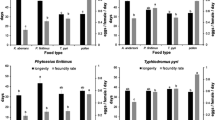Abstract
Nine species of macrochelid mites [Macrocheles “glaber” (Müller),M. aestivus Halliday,M. mammifer Berlese,M. peniculatus Berlese,M. robustulus (Berlese),M. merdarius (Berlese),M. peregrinus Krantz,M. eurygaster Krantz,Glyptholaspis confusa (Foà) were tested in the laboratory as predators of 2 species of dung-breeding pest flies (Musca vetustissima Walker,Haematobia irritans exigua de Meijere). The mites varied in their ability to attack the 2 fly species at both egg and larval stages. larger mites were generally more effective predators than the smaller species. The level of predation imposed byM. “glaber” onMusca vetustissima also varied with the developmental stage of both predator and prey.
Résumé
Neuf espèces d'Acariens Macrochelidae [Macrocheles “glaber” (Müller),M. aestivus Halliday,M. mammifer Berlese,M. peniculatus Berlese,M. robustulus (Berlese),M. merdarius (Berlese),M. peregrinus Krantz,M. eurygaster Krantz,Glyptholaspis confusa (Foà)] ont été essayés comme prédateurs de 2 espèces de mouches évoluant sur bouses (Musca vetustissima Walker,Haematobia irritans exigua de Meijère). La capacité prédatrice des acariens varie pour chaque espèce de mouche seion le stade de développement de celle-ci: oeuf ou larves. Les acariens les plus gros sont en général des prédateurs plus efficaces que les plus petits. Le niveau de prédation dû àM. “glaber” surM. vetustissima varie aussi en fonction du stade de développement du prédateur et de sa proie.
Similar content being viewed by others
References
Doube, B. M., Macqueen, A., &Huxham, K. A. — 1986. — Aspects of the predatory activity ofMacrocheles peregrinus [Acarina: Macrochelidae] on two species ofHaematobia fly [Diptera: Muscidae]. —Misc. Publ. Entomol. Soc. Amer., 61, 132–141.
Halliday, R. B. &Holm, E. — 1986. Experimental taxonomy of Australian mites in theMacrocheles glaber group [Acarina: Macrochelidae]. —Exp. Appl. Acarol., 1, 277–286.
Krantz, G. W. — 1983. Mites as biological control agents for dung-breeding flies, with special reference to the Macrochelidae. In: Biological Control of Pests by Mites (M. A. Hoy, G. L. Cunningham &L. Knutson, eds.). —University of California, Berkeley, pp. 91–98.
Tyndale-Biscoe, M., Wallace, M. M. H. &Morton, R. — 1981. Arthropod-induced mortality in immature stages of the bush fly,Musca vetustissima Walker [Diptera: Muscidae]. —Bull. Entomol. Res., 71, 681–690.
Walker, J. M., &Doube, B. M. — 1984. Susceptibility to drowning of eggs of the dung breeding fliesHaematobia irritans exigua andMusca vetustissima [Dipt.: Muscidae] in relation to dung beetle activity. —Z. Angew. Entomol., 98, 518–527.
Wallace, M. M. H., Tyndale-Biscoe, M., &Holm, E. — 1979. The influence ofMacrocheles glaber on the breeding of the Australian bushfly,Musca vetustissima in cow dung. In: Recent Advances in Acarology, vol. II. —Academic Press, New York. pp. 217–222.
Wallace, M. M. H. &Holm, E. — 1984. Competition between species of predatory macrochelid mites in the cow-dung pad. In: Acarology VI, vol. 1. (D. A. Griffiths &C. E. Bowman eds.). —Ellis Horwood, Chichester, pp. 581–584.
Author information
Authors and Affiliations
Rights and permissions
About this article
Cite this article
Halliday, R.B., Holm, E. Mites of the familyMacrochelidae as predators of two species of dung-breeding pest flies. Entomophaga 32, 333–338 (1987). https://doi.org/10.1007/BF02372442
Received:
Accepted:
Issue Date:
DOI: https://doi.org/10.1007/BF02372442




